by Ocean Robbins: The meanest pieces of gym equipment have got to be treadmills, spin bikes, and ellipticals.
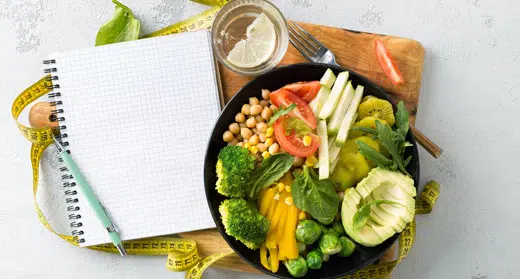 We are proud to announce a new partnership with John and Ocean Robbins and the Food Revolution to bring our readers Summits, Seminars and Masterclasses on health, nutrition and Earth-Conscious living.
We are proud to announce a new partnership with John and Ocean Robbins and the Food Revolution to bring our readers Summits, Seminars and Masterclasses on health, nutrition and Earth-Conscious living.
Sign Up Today For the Healthy Brain Masterclass
They’ve got this LCD display that cycles between time, distance, pace, and calories burned. Every 20 seconds or so, the machine informs the exerciser that their caloric expenditure has just increased infinitesimally. By the end of a grueling workout, you might learn that you’ve burned off the equivalent of three small squares of dark chocolate.
If you’ve ever had this experience, you may be wondering how in the world anyone maintains anything close to a healthy weight. Food contains so many calories, and physical exertion doesn’t seem to burn anywhere near the number required for equilibrium, let alone weight loss.
In our culture, pretty much everything related to weight loss — and body composition and health in general — ends up being reduced to a discussion about calories. We constantly have calorie awareness from food labels, the media, the fitness industry, and the behemoth food advertising industry. So do calories matter?
Should we pay close attention to nutrition labels whose largest, boldest font is devoted to calories per serving of packaged foods, and choose the ones labeled “low-calorie”? Should we enter every bite we take into an online database or counting app to make sure we don’t overconsume calories? And do we really need to count calories? Or might calorie counting be unnecessary or even counterproductive? What if we simply paid attention to our bodies’ signals of hunger and satiety (the sense of feeling full and satisfied), and eat as much as we want, like every wild animal ever? (Because when was the last time you saw an overweight gazelle or cheetah?)
In this article, we’ll look at calories, and how they do or don’t fit into our weight and health journeys. We’ll explore when it’s helpful to count calories, and when it’s more important to pay attention to and prioritize other things like overall nutrition.
What Are Calories?
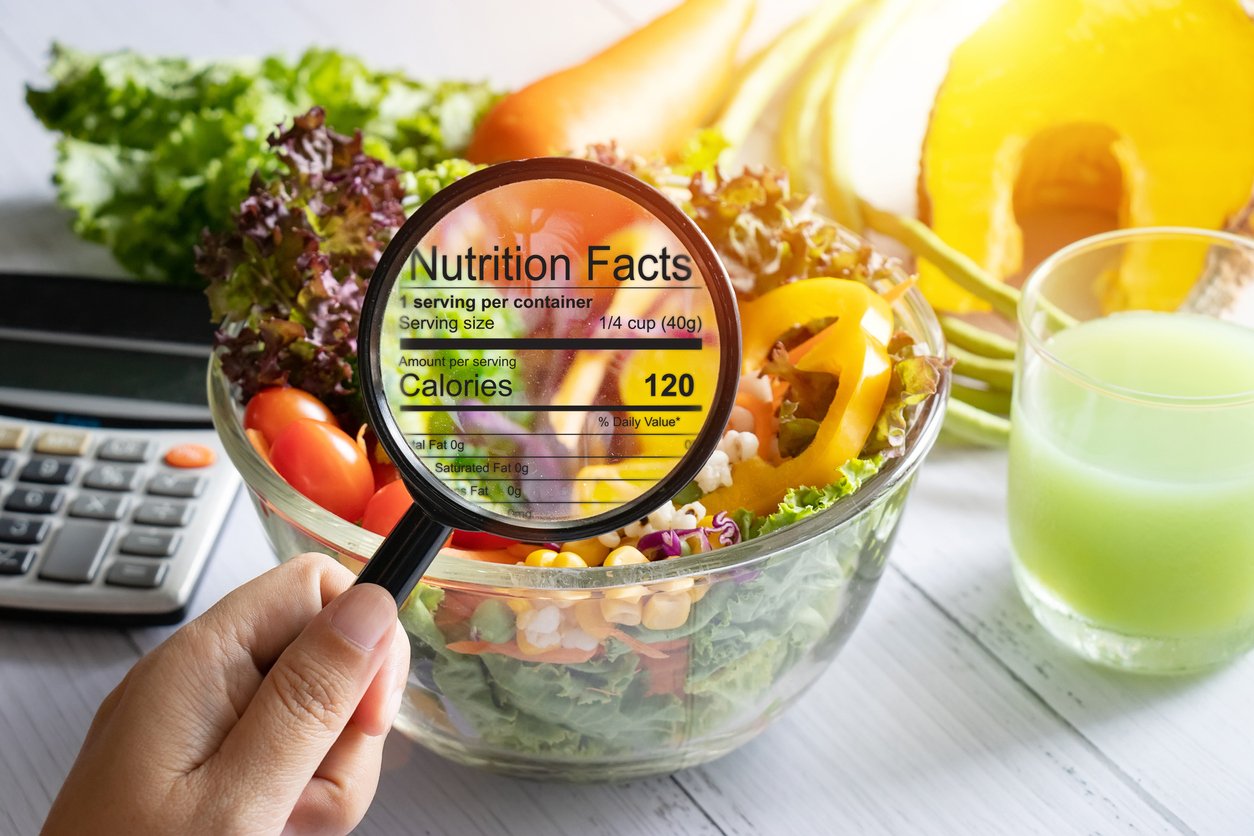
iStock.com/asiandelight
A calorie is nothing more or less than a unit of energy. The number of calories in a food is the amount of energy that food can provide. And by energy I don’t mean a subjective experience of being “amped up” — caffeine and other stimulants can do that without using any calories — but rather the energy that your body uses to run itself, powering everything from breathing to thinking to digesting to keeping warm to tissue repair to immune function, as well as voluntary movement like working out or playing sports.
All this energy originally comes from the sun, which plants learned how to convert into their own life force through the miracle of photosynthesis. When you eat plant-based foods, you’re just part of a long lunch line whose original supplier is our nearest star.
And the calorie is a way of quantifying how much energy is in a thing — technically, how much energy will be released if that thing is burned up completely. What we call a calorie (which is technically 1,000 calories, but I’d rather not get into that whole story, because it’s confusing and kind of pointless) on food labels and treadmill displays is the amount of energy that is required to raise the temperature of one kilogram of water by one degree Celsius. And originally, that’s exactly how researchers measured the energy content of food — they placed a specific weight of the food into a “bomb calorimeter,” which is basically a small oven surrounded by water, and not an invention by a Bond villain to make the whole world obese. The food would be completely combusted, and the temperature of the surrounding water would be measured pre- and post-burning.
Nowadays, for the most part, we estimate calories in foods using the Atwater system, adding up the amounts of calorie-containing macronutrients — carbohydrates (4 calories per gram), protein (4 calories per gram), fat (9 calories per gram), and alcohol (7 calories per gram).
How Many Calories Do I Need?
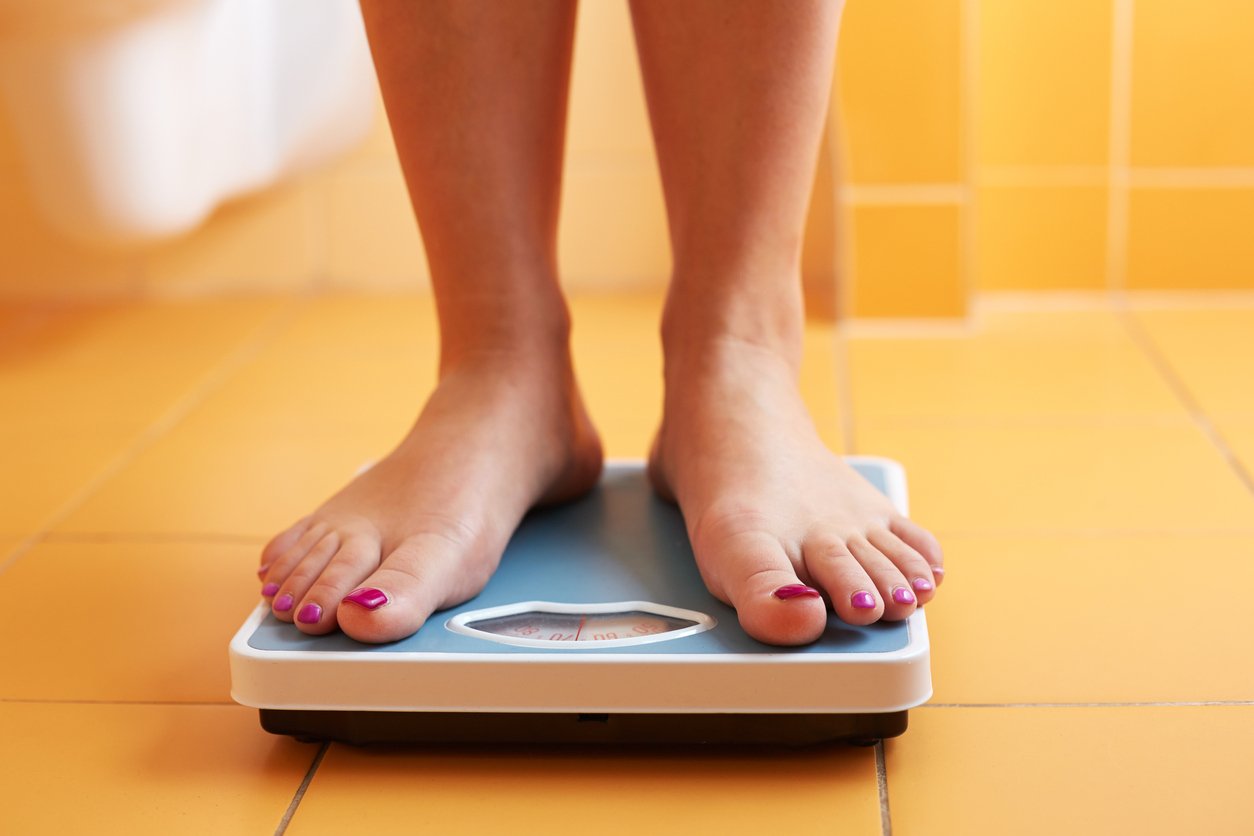
Quantifying the calories in food is pretty straightforward. But figuring out how many calories you burn is far more complex, for several reasons.
- First, we’re all different. While nutrient recommendations for adults typically stem from a 2,000 calorie-per-day intake, calorie needs can vary wildly between individuals. A 22-year-old female college athlete needs far more calories than an 86-year-old man who leads a predominantly sedentary lifestyle. Calorie needs for men and women 19+ years old may range from about 1,800–3,000 calories per day (or more, for some elite athletes), depending on a variety of factors. That’s a pretty wide range.
If you want to figure out where you land, the most commonly used tool is the Mifflin-St Jeor equation, which takes into account your age, weight, height, and sex. It calculates your resting metabolic rate (RMR), also known as basal metabolic rate (BMR), or how many calories you burn while at rest.
Mifflin-St Jeor, which was first published in a scientific paper in 1990, appears to be more accurate than other equations (to within 10% of actual laboratory measures) and has a narrower range of possible error.
After all that buildup, I hope you like mathematics and that you’re ready for the formula, because here’s how to calculate daily calories:
Females: (10 x weight [kg]) + (6.25 x height [cm]) – (5 x age [years]) – 161
Males: (10 x weight [kg]) + (6.25 x height [cm]) – (5 x age [years]) + 5
And whatever number you get, multiply it by one of the following:
- Sedentary: 1.2
- Lightly active: 1.375
- Moderately active: 1.55
- Active: 1.725
- Very active: 1.9
So a moderately active 45-year-old and 5’6” (168 cm) woman weighing 130 pounds (59 kg) would get the following result:
[(10 x 59) + (6.25 x 168) – (5 x 45) – 161] x 1.55 = 1,943.7 calories per day
Calories for Weight Management
In general, when you eat the number of calories that matches your BMR, you maintain your current weight. If you regularly consume more calories or energy than you burn off in a day, you will gain weight. And if you regularly consume fewer calories than are burned off in a day, you lose weight.
You may have heard conflicting opinions about this. Wellness influencers and those selling unproven weight loss solutions often claim that “calories in, calories out” is not the whole picture, and that their particular approach can help people lose weight without cutting down on eating or amping up on exercise — which is what lots of people want to hear.
But while weight management is nuanced and complex, all that nuance and complexity eventually does ultimately get filtered through the consumption and expenditure of calories. This has been shown pretty conclusively, for many decades now, in overfeeding studies. When people eat more calories than they burn, they gain weight.
Calories Aren’t the Whole Story

At this point, you may be wondering how anyone lacking access to a bomb calorimeter, calorie calculator, food nutrition database, and lots of time on their hands could possibly figure out their caloric requirements. And yet, humans and nonhuman animals have somehow managed to get this stuff just right for millions of years.
So there must be more to the story of weight management than just calorie counting. In fact, some public health officials see a preoccupation with calories as a problem, putting people at risk of chasing one number while losing sight of the bigger picture of consuming a healthy, balanced diet.
The Quality of Calories Matter
While paying attention to calories can keep you aware of your energy intake and output, which is a good thing if you’re trying to lose or gain weight, they don’t inform the quality of your overall diet. A focus on counting calories and tracking numbers may distract people from meaningful health practices and outcomes. Instead of placing attention on nutrients and nutritional quality of foods, there are countless programs and advertisements that teach people to prioritize quantity over quality of their diet.
What’s often overlooked in this messaging is that the kinds of foods you eat are at least as important as how much. When you choose healthy, nutrient-dense, fiber-rich, and hydrating foods, you are eating in a way that will give you a healthier weight, better blood sugar regulation, improved blood lipids, and a reduced overall risk of chronic disease.
Taking the Anxiety Out of Eating
And some people may find that the stress that comes from counting calories takes away some of the joy of eating. If counting calories is used as a tool to facilitate healthy weight loss that’s one thing, but if counting calories causes mental anxiety and puts too much focus on numbers versus quality, it’s probably better to find another approach.
In my view, eating at its most fundamental level is about nourishing your body, which should be a pleasurable experience. I mean, every animal chooses its food based on pleasure signals. If it tastes good, it must be healthy. That’s how evolution works — nobody could have survived if we weren’t guided by “yummy” and “yucky” to figure out which berries were ripe and delicious and which ones were poisonous.
Processed Foods Are a Problem
So what happened to us? Why do we distrust our own taste buds and satiety, and impose counting systems to make us eat “healthy” foods that don’t fill us with pleasure? You can blame skewed social values and the ascendance of diet culture, but all that arose to address the problem caused by the real culprit — ultra-processed foods.
Some people blame their bodies for being overweight, like, “Well, I have such a strong sweet tooth that I can’t say no to rich desserts.” In a world of unprocessed foods (a world that our ancestors lived in until relatively recently), a sweet tooth guided them to ripe apples instead of green ones and helped them remember where the wild figs grew and when they’d be in season. These days, that same sweet tooth has been hijacked by an industrial food supply. Next to a candy bar manufactured to stimulate certain taste receptors, a ripe apple no longer tastes that sweet.
Once your taste buds have calibrated to ultra-processed foods (and it’s not just sugar, but salt, fat, and artificial ingredients that also come in forms, concentrations, and quantities not found in nature), you can no longer rely on natural processes like pleasure and satiety to guide you.
Nutrient Density vs Calories
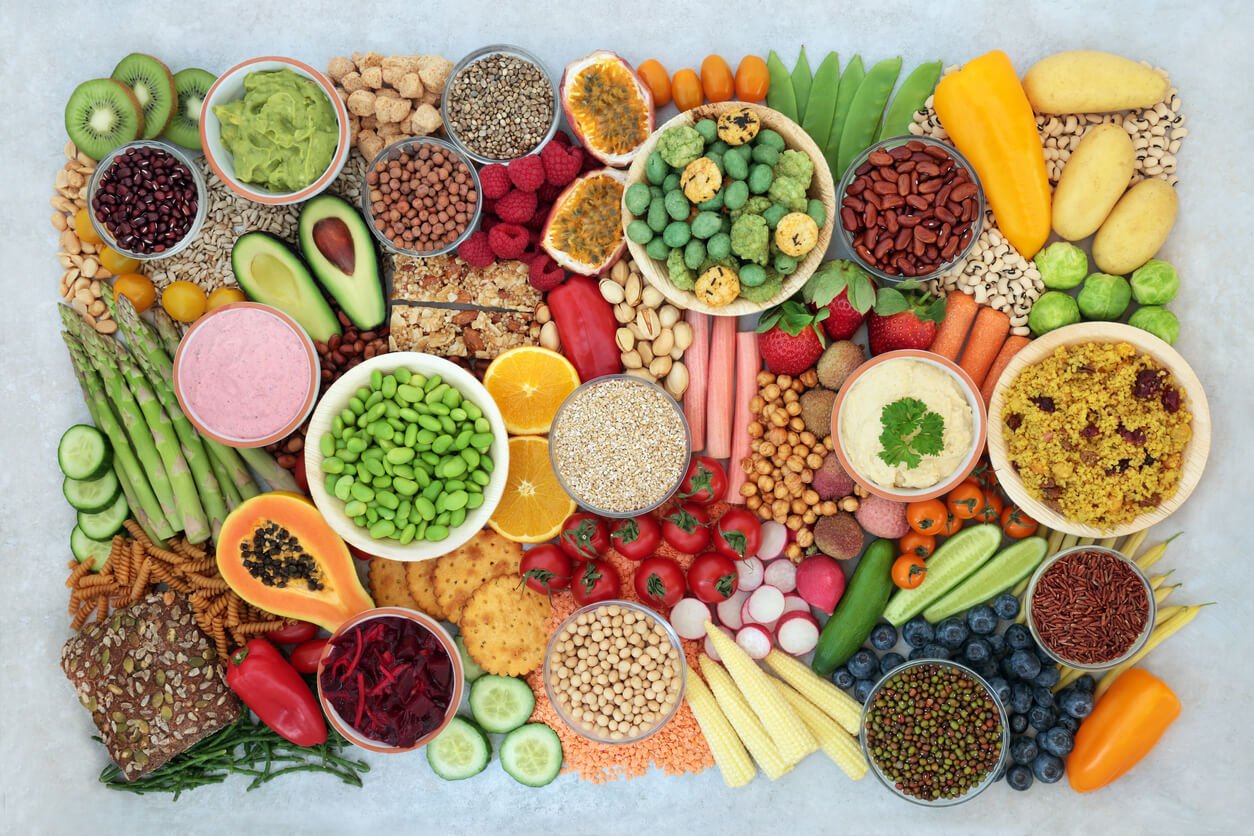
If you focus on eating a variety of high-quality foods and avoiding highly processed ones, you may discover that counting calories doesn’t matter as much and isn’t necessary to achieve and maintain your desired weight.
By high-quality, I mean foods found in nature that have a high nutrient density ratio. You can think of nutrient density as the amount of micronutrients (e.g., vitamins, minerals, antioxidants, phytochemicals, etc.) per calorie. Nutrient-poor foods are those that are high in calories and fat, but low in nutrition. Nutrient-rich foods, on the other hand, also contain lots of fiber and water, both of which help you feel full, which reduces the desire to overeat.
Examples of nutrient-dense foods include:
- Fruits (berries, bananas, citrus fruits, grapes, mangoes, peaches, pears, etc.)
- Vegetables (cruciferous veggies, alliums, sweet potatoes, carrots, squash, tomatoes, etc.)
- Whole grains (quinoa, brown rice, amaranth, barley, farro, millet, oats, etc.)
- Legumes (beans, peas, and lentils)
Some plant-based whole foods, while health-promoting, are very high in calories and low in water, meaning they deliver a lot of calories by weight. Nuts and seeds — such as cashews, almonds, walnuts, Brazil nuts, and chia, hemp, flax, pumpkin, and sesame seeds (and peanuts, too, which are technically legumes) — can absolutely be part of a healthy diet, but may be omitted or eaten in small quantities if weight loss is a primary goal.
Dr. Greger’s Daily Dozen
Michael Greger, MD, founder of NutritionFacts.org, promotes his “Daily Dozen” as a balanced and varied approach to nutrient-rich eating. Here’s how he describes the protocol (throwing in calorie burning at the end for good measure):
“Each day, I recommend a minimum of three servings of beans (legumes), one serving of berries, three servings of other fruits, one serving of cruciferous vegetables, two servings of greens, two servings of other veggies, one serving of flaxseeds, one serving of nuts and seeds, one serving of herbs and spices, three servings of whole grains, five servings of beverages, and one serving of exercise (90 minutes at moderate intensity or 40 minutes of vigorous activity).”
Other Recommendations to Help Naturally Cut Calories
The Daily Dozen is a great high-level guide. To help with the details of putting together healthy meals and snacks, you can also use the search function on our website (foodrevolution.org) to search for a specific ingredient or dish. Here are some topics to get you started:
A Plant-Based Meal Prep Guide in 6 Easy Steps
11 Top Weight Loss-Friendly Foods
Healthy Crunchy Snacks
One of the easiest ways to cut “sneaky” calories from your diet is to replace sugary and fatty beverages with healthy ones. For some reason, our bodies don’t compensate fully for liquid calories — we get stronger satiety signals from calories eaten in solid form.
Healthy beverages that won’t break the caloric bank include water, coffee, tea, and whole food smoothies that aren’t too sweet. Here’s a full article on healthy morning drinks to start your day off right.
How to Stop Eating When You’ve Had Enough
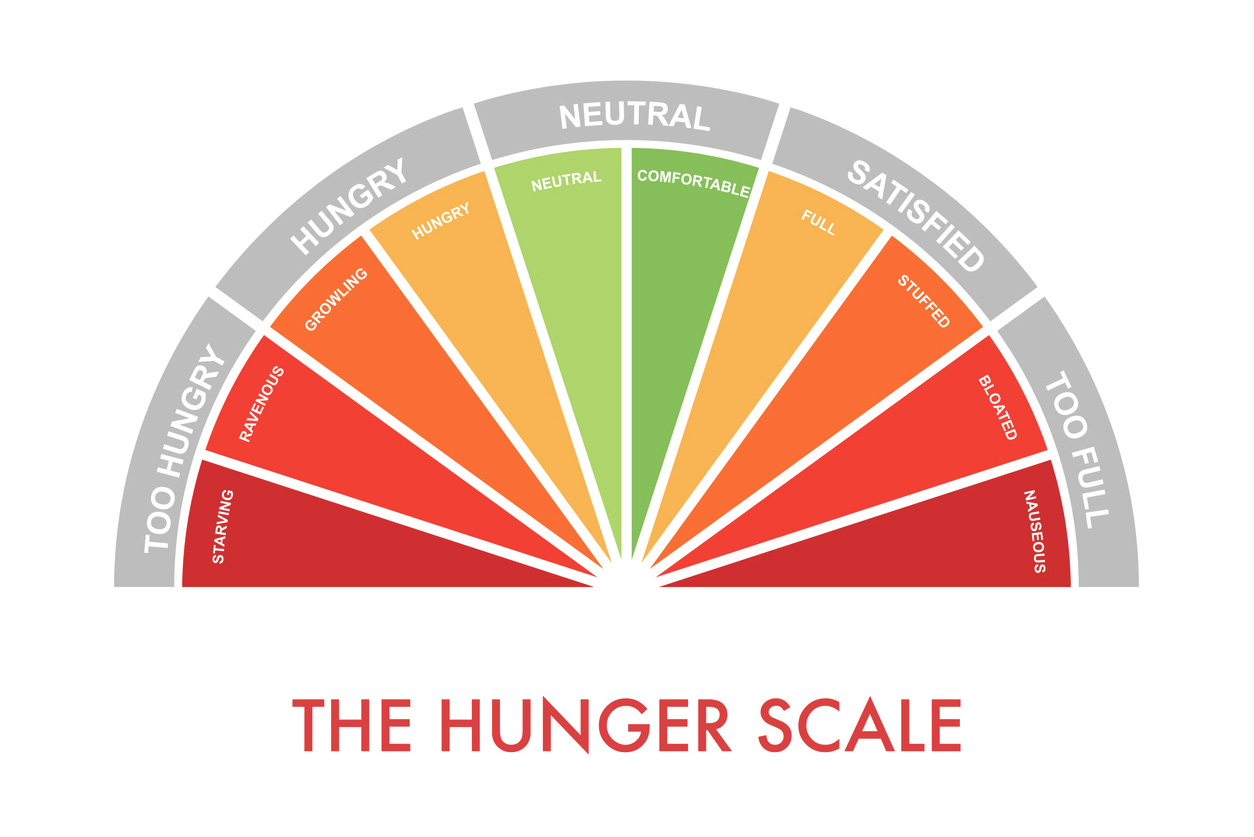
The best way to determine whether you’re eating enough, too much, or not enough, is to tune in to your body. That’s not an easy thing to do in our modern world. Many of us eat in the car and on the run. When we are sitting down, we may be distracted by our screens or conversations with others. Just as we can drive a familiar route without paying conscious attention to accelerating, braking, and turning, we can eat without noticing the taste or texture of the food and how our bodies change as we eat.
Mindful eating can help you here, by bringing awareness to subtle satiety signals you may have been missing. You probably know when you’re uncomfortably hungry and when you’re uncomfortably full. Think of those states as 0 and 10 on a line. You probably want to avoid both states, and aim for the sweet spot between 3 and 8. Refrain from eating until you feel actual hunger, and eat only until you’re about 80% full, as many of the longest-lived people on Earth do.
One way to manage your hunger and fullness is to eat at the same times every day, which helps your body get used to becoming hungry around those times.
A different approach that works for some people with food addictions is Susan Peirce Thompson’s Bright Line Eating program. Susan’s four bright lines provide a structure that many folks who are highly susceptible to food addiction have found helpful.
If you’re not sure where to start, consider meeting with a registered dietitian who can help assess your current dietary pattern, discuss your goals and preferences, and help you make a plan for improving the quality of your diet. Studies show people are not always great at estimating calorie intake, so professional guidance may help for specific goals.
When Counting Calories is Helpful
While most people don’t need to count calories for their general health, there may be some instances in which tracking calories can be a helpful tool. If you’re working to reverse excess weight, eating below your BMR can promote a sustainable, consistent loss of one to two pounds per week without over-restriction.
For those looking to add muscle and lose fat, such as bodybuilders, counting calories can be a helpful part of an overall fitness plan.
And if you’re underweight and trying to put on some pounds, or if you’re suffering from malnutrition, eat above your BMR to promote weight gain. In this case, you may want to add nutritional shakes and high-calorie snacks that are whole and plant-based. This is where those nuts, seeds, and avocados can really help.
If you’re an athlete in the middle of intense training, or just have a very active lifestyle, you may also need more calories to support your physical performance and recovery.
Apps to Help You Track Nutrient Intake
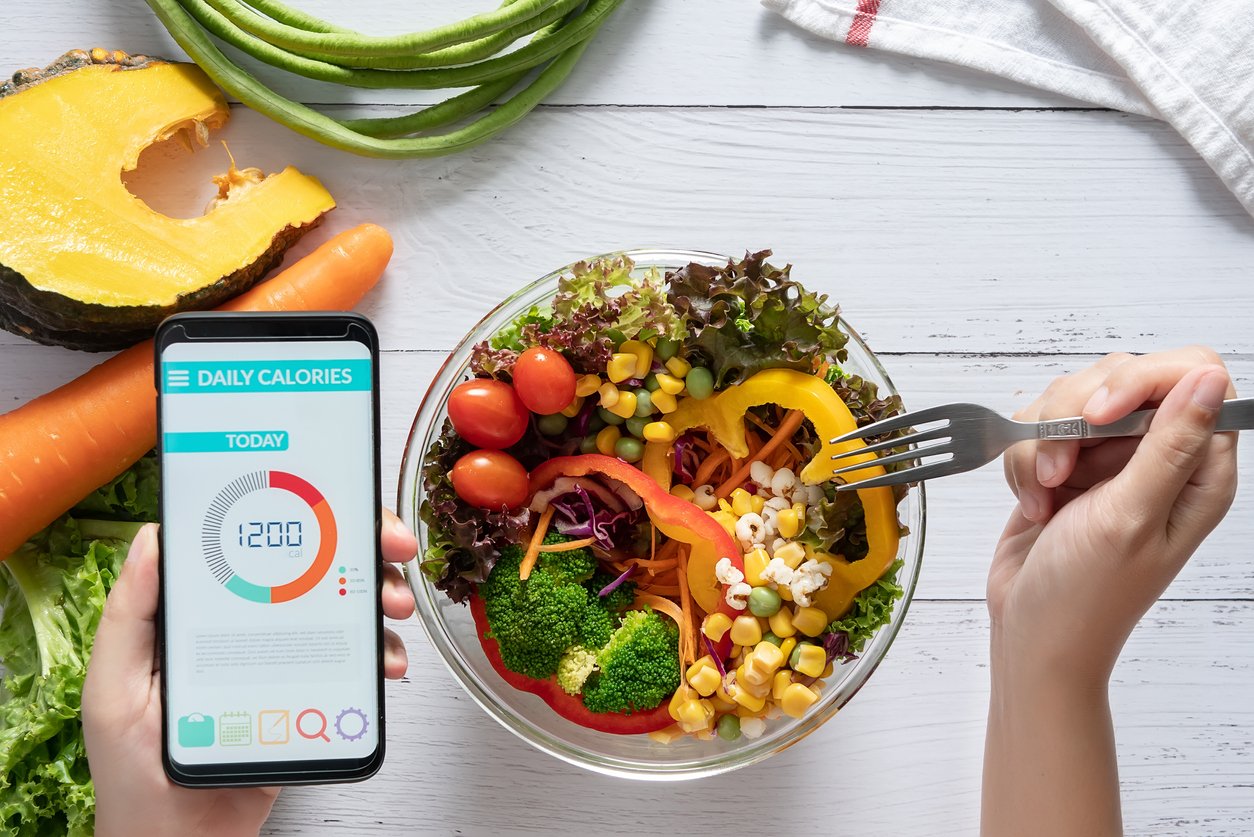
Plenty of smartphone apps can help count calories. But unless you have a specific reason to focus on numbers, you might find it more useful to choose one that helps you track the overall quality of your nutrient intake, either instead of or in addition to simply counting calories.
Dr. Greger’s Daily Dozen app, available on the Apple iOS store and Google Play, provides a checklist of 12 recommended foods and activities to aim for every day.
Cronometer also comes as an app for iOS and Google. It counts not only calories but also macro- and micronutrients.
And many people use MyFitnessPal (iOS and Google), which calculates your caloric and nutrient intake by comparing your inputted meals with a giant food database.
Finally, if you’re looking to track your food intake and don’t want to look at calories at all, check out Ate, which bills itself as a mindful food journaling app. Instead of writing down what you ate, snap a photo of the meal or snack with your phone, tap your motivation for eating (hungry, bored, stressed, cravings, time, etc.), and indicate to what extent that food was on-path or off-path based on your goals.
Low Calorie Recipes with High Nutrition
Calories will be the least of your focus when you try these wholesome plant-based dishes.
If you’re counting your veggies, though, our savory Breakfast Cauliflower Lentil Kitchari serves up two vegetable servings and a serving of whole grain fiber, plus a bounty of flavorful herbs and spices.
Southwest Stuffed Sweet Potatoes are the complete nutrient-dense package, with a spacious surface area for layering on lots of delicious nutrition.
In our Blueberry Banana Chia Pudding, you’ll find sweet, creamy banana, antioxidant-rich blueberries, and omega-3-rich chia seeds, blended with plant-based milk and fiber-rich organic rolled oats. Topped with crunchy almonds and cacao nibs, it’s a healthy snacker’s dream!
High-quality, nutrient-dense meals are filling, delicious, and simple to prepare. We hope you enjoy them as much as we do!
1. Breakfast Cauliflower Lentil Kitchari
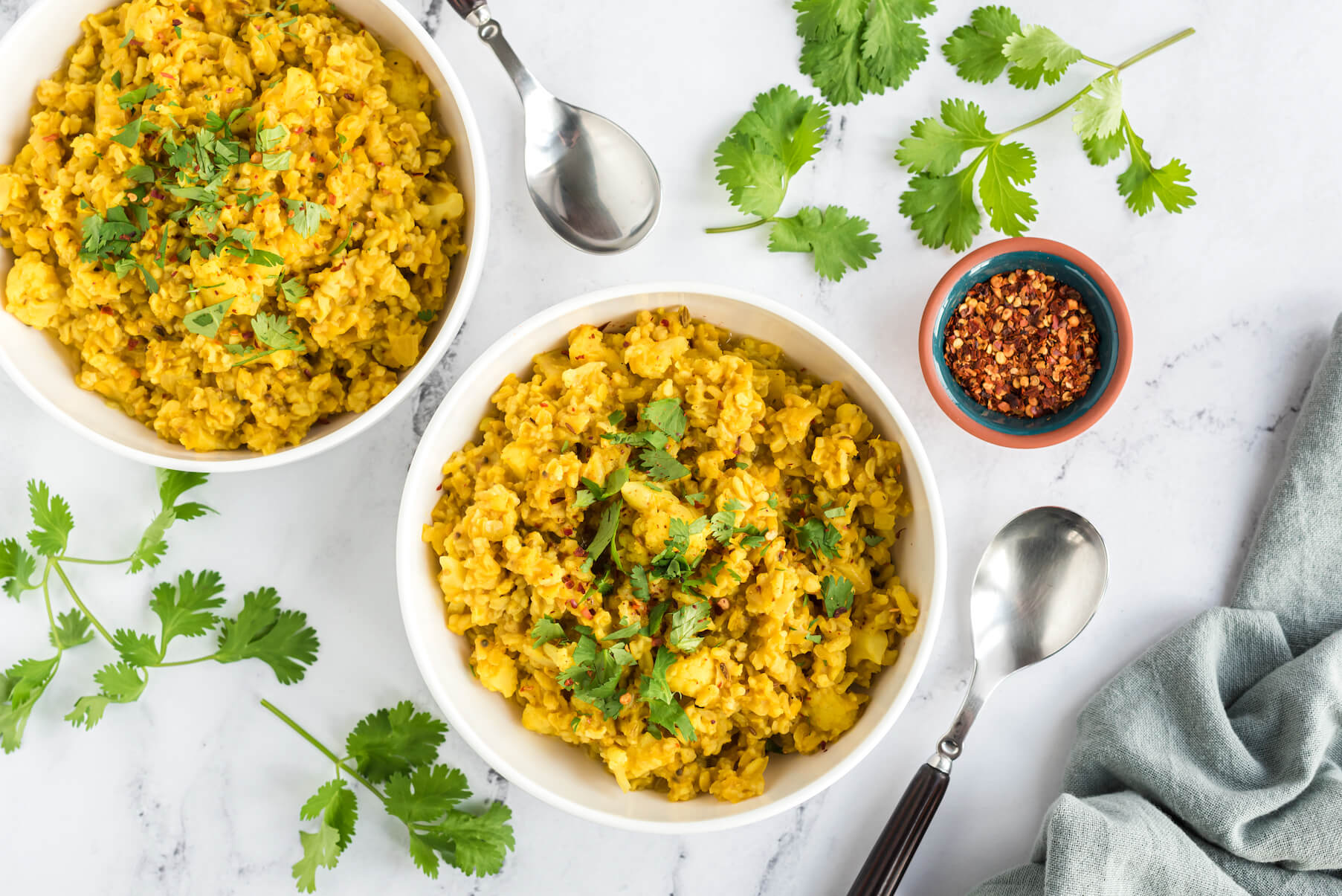
Traditionally, kitchari (which means mixture) is a combination of rice and mung beans in a warm soup-like dish, although a variety of grains and legumes, like the lentils in our version, can be used. A deliciously hearty and nutritious way to begin your morning, Breakfast Cauliflower Lentil Kitchari is yummy warm or cold, and is actually more flavorful the next day. Make it the night before and enjoy it in the morning for a comforting breakfast that will energize you for the rest of the day with its fragrant spices, fiber-filled grains, protein-packed lentils, and healing cauliflower.
2. Southwest Stuffed Sweet Potatoes
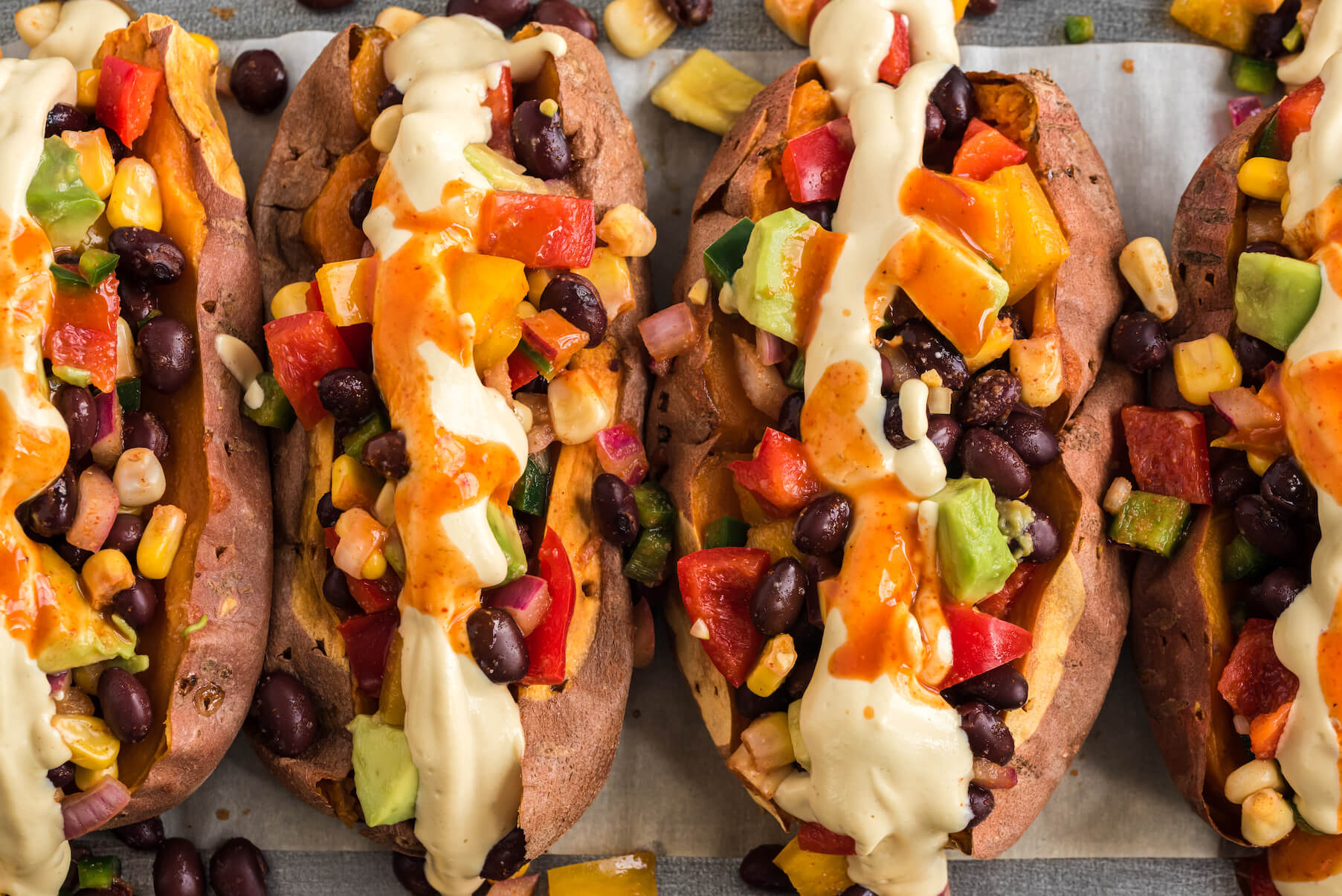
When it comes to nourishing your body, these Southwest Stuffed Sweet Potatoes offer a big nutritional bang for your caloric buck. The naturally sweet orange vessels are power-packed with carotenes and fiber, plus space for a protein-packed and phytonutrient-rich black bean and sweet corn medley, delightfully creamy avocado, and flavorful herbs and spices. If you’re striving to center your nutrition around consuming nutrient-dense foods, this recipe certainly will help get you there!
3. Blueberry Banana Chia Pudding

Consider this a foundational meal upon which you can build countless variations. In one serving of this yummy pudding as-is you get two servings of fruit (blueberries and banana) and one serving of protein- and omega-3-rich chia seeds, as well as a serving of fiber-rich whole grains. Start your day with this nutrient-rich pudding, and we’re pretty sure your taste buds, belly, and mind will be singing happy tunes!
















































